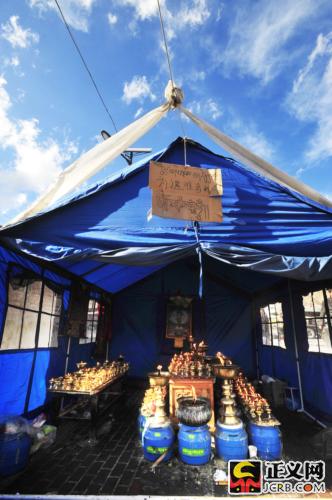Hundreds of butter lamps lit up on King Gesar Square
Hundreds of mourners filled King Gesar Square in Yushu prefecture yesterday to pay a silent tribute to the victims of last week's earthquake, the China News Service reported.
Dronma Nima, 50, spun her prayer wheel throughout the tribute in a traditional Tibetan gown. In Tibetan Buddhism, this would guide the souls of the dead through sufferings to heaven.
 |
|
A blue tent was?built up as a temporary mourning center on the King Gesar Square. |
King Gesar Square is significant to Tibetan people for having the world's largest statue of King Gesar, a legendary hero of the Tibetan ethnic group.
Early in the morning, 33-year-old Tenzin Darje reached the square and lit a butter lamp in a blue tent. In Tibetan culture, this was a way to offer tribute to the dead. As most buildings were destroyed by the quake, the tent was built up as a temporary mourning center.
Tenzin Darje also wore a white paper flower on his chest, which was a symbol of mourning in traditional Chinese culture. He said he was willing to do so because this was a national tribute.
When the three-minute ritual was over, a young Tibetan man suddenly knelt down, startling all the people beside him. He murmured influent Mandarin to thank the government and other people for giving him so much care and timely aid.
The man was called Tashi Dawa. Both he and his brother were injured in the earthquake. Their house also was destroyed. "I was in despair at the time, but soon the soldiers arrived and saved us," he said.
Tashi Dawa was living in a temporary tent and his injury was treated. His biggest hope was to build up a new home with government aid.
The 7.1-magnitude earthquake left 2,183 people dead, 84 missing, and 12,135 injured as of April 21, 2010.
 0
0 






